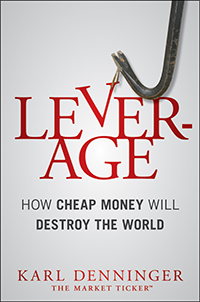... and it does not matter what the topic is.
I've written on this before but I believe it bears repeating: You can choose the basis of evaluation for virtually anything but if the outcome matters to you then there is only one acceptable decision, and that is engineering-based.
Engineering takes the current circumstances as the "baseline" and refuses to accept any path which cannot be proved to make it better, and further expects that if you represent it will be better and it isn't you lose all the money you made and if harm comes to others you go to prison.
No exceptions are allowed.
If the bridge has a sign on it that says "10 ton weight limit" provided your vehicle does not mass more than ten tons it must be safe to drive across said bridge no matter how many other vehicles are on the bridge. The sign didn't say "one vehicle only", it said "10 ton weight limit." The engineer who specified that has certified that provided the materials were not fraudulently sourced and that the bridge was assembled according to his stamped plans it is safe for you to drive over it with a vehicle that masses no more than ten tons.
Period.
We must apply this to all matters of public policy, particularly when we consider same to be more than a suggestion. The NEC works this way; you can run 20 amps on 12 gauge non-metallic wire (e.g. type NM, usually called "Romex") in a house. If the breaker is not larger than 20 amps the wire will not overheat and catch your house on fire provided it is actually the specified 12 gauge and made out of copper. Every wire downstream from that breaker which connects between things must be 12 gauge for this reason; the breaker protects the wire and the engineering standard says that this combination will produce a safe -- that is, the wire will not overheat and catch your house on fire -- outcome. (Yes, this is a bit simplified and the tables have "but for" limitations, but its generally the case.)
Note that while this table was developed using engineering any runt with a pair of lineman's pliers and some wire staples can run cable without being able to do the calculations to independently determine this. A table is sufficient for an electrician wiring your house; he does not have to understand the math, only the rules which are clearly on the table.
Now it may be the case that in certain circumstances you may not find the performance acceptable but provided you follow that "engineering" rule in a typical residence per the table it is safe.
The standard against one judges in this paradigm is always the status quo; that is, a bridge must not fall down because while you may find it inconvenient (or even unacceptable) to not be able to cross the river without it (absent either a boat or swimming) you won't fall from height and possibly be crushed by the debris without the bridge existing, and obviously a person now under the bridge and subject to having tons of concrete and steel fall on him can't have that happen if its not there. That is, the status quo is that you are safe from being crushed from above or dropped from height and thus that status quo must not be violated by building the bridge. If you cannot assure that and, if it that standard is violated someone will be punished for it appropriately, including being asset-stripped, thrown in prison or even executed then you must not build the bridge. Period.
We must apply this to the status quo when it comes to energy, medicine, appliances and everything else -- and insist that our governments do so without exception. Further, for those who make said policy or act on it if they violate this stricture they must be held personally accountable for all of the damage that occurs without exception -- no "waivers" or "immunity" may ever be permitted in that regard.
Want a real goal for 2024 in terms of enforcing a change in our so-called "social contract"?
Now you have one.


